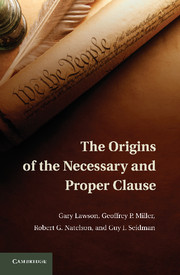Book contents
- Frontmatter
- Contents
- Acknowledgments
- 1 Raiders of the Lost Clause
- 2 Discretionary Grants in Eighteenth-Century English Legislation
- 3 An Ocean Away
- 4 The Legal Origins of the Necessary and Proper Clause
- 5 The Framing and Adoption of the Necessary and Proper Clause
- 6 Necessity, Propriety, and Reasonableness
- 7 The Corporate Law Background of the Necessary and Proper Clause
- Index
- References
5 - The Framing and Adoption of the Necessary and Proper Clause
Published online by Cambridge University Press: 03 May 2011
- Frontmatter
- Contents
- Acknowledgments
- 1 Raiders of the Lost Clause
- 2 Discretionary Grants in Eighteenth-Century English Legislation
- 3 An Ocean Away
- 4 The Legal Origins of the Necessary and Proper Clause
- 5 The Framing and Adoption of the Necessary and Proper Clause
- 6 Necessity, Propriety, and Reasonableness
- 7 The Corporate Law Background of the Necessary and Proper Clause
- Index
- References
Summary
DRAFTING THE NECESSARY AND PROPER CLAUSE AT THE CONSTITUTIONAL CONVENTION
Original Intent vs. Original Understanding vs. Original Meaning
Under the founders' rules of interpretation, deducing the force of the Constitution requires that one read the text as it was understood by the ratifiers (“original understanding”). When a coherent original understanding is not recoverable – due to lack of evidence or contradictory evidence – the interpreter must seek the meaning of the document that a reasonably well-informed hypothetical ratifier would have ascribed to it (“original meaning” or “original public meaning”). The intent of the delegates at the drafting convention (“original intent”) has no direct legal force, but often provides evidence of the understanding or meaning at the time of ratification.
In the case of the Necessary and Proper Clause, the convention record is particularly useful for deducing the understanding and meaning at the ratification because the delegates who, directly or indirectly, were most responsible for shaping the Clause all served as leading ratification figures as well. Those delegates were Charles Pinckney of South Carolina and John Dickinson of Delaware and the five members of the drafting committee: John Rutledge of South Carolina, Edmund Randolph of Virginia, James Wilson of Pennsylvania, Oliver Ellsworth of Connecticut, and Nathaniel Gorham of Massachusetts. All except Gorham later assumed major roles in representing the Constitution to the ratifying public, and all except Dickinson were delegates in their state ratifying conventions.
- Type
- Chapter
- Information
- The Origins of the Necessary and Proper Clause , pp. 84 - 119Publisher: Cambridge University PressPrint publication year: 2010

